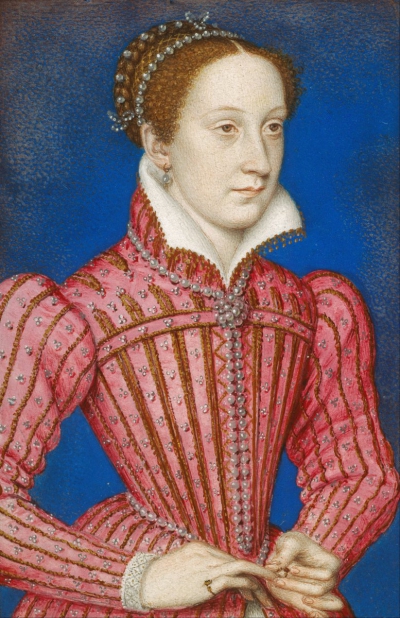Henry Stuart, Lord Darnley (1546 10 February 1567), was an English nobleman who was the second husband of Mary, Queen of Scots, and the father of James VI of Scotland and I of England. Through his parents, he had claims to both the Scottish and English thrones, and from his marriage in 1565 he was king consort of Scotland. Less than a year after the birth of his son, Darnley was murdered at Kirk o' Field in 1567. Many contemporary narratives describing his life and death refer to him as Lord Darnley, his title as heir apparent to the Earldom of Lennox, and it is by this appellation that he is known in history.
Mary, Queen of Scots (8 December 1542 – 8 February 1587), also known as Mary Stuart or Mary I of Scotland, was Queen of Scotland from 14 December 1542 until her forced abdication in 1567.
The only surviving legitimate child of James V of Scotland, Mary was six days old when her father died and she acceded to the throne. During her childhood, Scotland was governed by regents, first by the heir to the throne, James Hamilton, Earl of Arran, and then by her mother, Mary of Guise. In 1548, she was betrothed to Francis, the Dauphin of France, and was sent to be brought up in France, where she would be safe from invading English forces during the Rough Wooing. Mary married Francis in 1558, becoming queen consort of France from his accession in 1559 until his death in December 1560. Widowed, Mary returned to Scotland in August 1561. Following the Scottish Reformation, the tense religious and political climate that Mary encountered on her return to Scotland was further agitated by prominent Scots such as John Knox, who openly questioned whether her subjects had a duty to obey her. The early years of her personal rule were marked by pragmatism, tolerance, and moderation. She issued a proclamation accepting the religious settlement in Scotland as she had found it upon her return, retained advisers such as James Stewart, Earl of Moray, and William Maitland of Lethington, and governed as the Catholic monarch of a Protestant kingdom.
Mary married her half-cousin, Henry Stuart, Lord Darnley, in 1565, and in June 1566, they had a son, James. In February 1567, Darnley's residence was destroyed by an explosion, and he was found murdered in the garden. James Hepburn, 4th Earl of Bothwell, was generally believed to have orchestrated Darnley's death, but he was acquitted of the charge in April 1567, and the following month, he married Mary. Following an uprising against the couple, Mary was imprisoned in Loch Leven Castle. On 24 July 1567, she was forced to abdicate in favour of her one-year-old son. After an unsuccessful attempt to regain the throne, she fled southward seeking the protection of her first cousin once removed, Elizabeth I of England. (Elizabeth was the granddaughter of Henry VII of England, and Mary was his great-granddaughter.)
Mary had once claimed Elizabeth's throne as her own and was considered the legitimate sovereign of England by many English Catholics, including participants in a rebellion known as the Rising of the North. Perceiving Mary as a threat, Elizabeth had her confined in various castles and manor houses in the interior of England. After eighteen and a half years in captivity, Mary was found guilty of plotting to assassinate Elizabeth in 1586 and was beheaded the following year at Fotheringhay Castle. Mary's life, marriages, lineage, alleged involvement in plots against Elizabeth, and subsequent execution established her as a divisive and highly romanticised historical character, depicted in culture for centuries.

1565Jul, 29
The widowed Mary, Queen of Scots marries Henry Stuart, Lord Darnley, Duke of Albany, at Holyrood Palace, Edinburgh, Scotland.
Choose Another Date
Events on 1565
- 23Jun
Great Siege of Malta
Dragut, commander of the Ottoman navy, dies during the Great Siege of Malta. - 29Jul
Henry Stuart, Lord Darnley
The widowed Mary, Queen of Scots marries Henry Stuart, Lord Darnley, Duke of Albany, at Holyrood Palace, Edinburgh, Scotland. - 8Sep
Great Siege of Malta
The Knights of Malta lift the Ottoman siege of Malta that began on May 18. - 11Sep
Great Siege of Malta
Ottoman forces retreat from Malta ending the Great Siege of Malta. - 18Oct
Battle of Fukuda Bay
Ships belonging to the Matsura clan of Japan fail to capture the Portuguese trading carrack in the Battle of Fukuda Bay, the first recorded naval battle between Japan and the West.

 English
English  español
español  français
français  português
português  русский
русский  العربية
العربية  简体中文
简体中文 